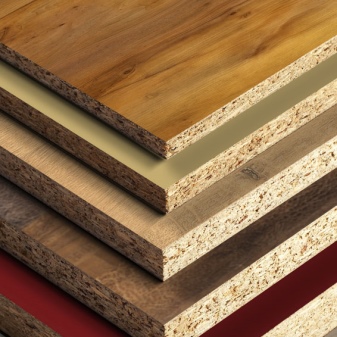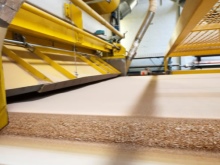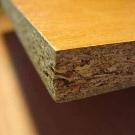Description of laminated chipboard and how to use them

A description of laminated chipboard and an understanding of what it is is absolutely necessary for absolutely any repair and construction, at least for comparing alternatives. It is critically important to understand when choosing a material, what is the density of moisture-resistant laminated chipboard, what options are there for their use, which material manufacturers should be trusted. Additionally, it is worth, of course, to study the main properties of wall panels and the features of their production, reviews of such products from consumers.


What it is?
First, it is worth pointing out that the decoding of the abbreviation chipboard means nothing more than laminated chipboard, that is, a chipboard covered with a special film. The emergence of slabs from shavings dates back to the 1930s. but they began to be mass-produced only in the post-war period, which is obviously connected with the difficult situation that arose then.
This also indicated a change in consumer tastes - heavy, artsy furniture and decoration were losing popularity. In the description of that time, it is not without reason that an unprecedented increase in speed and dynamism is noted in everything, including building materials.


The main composition of the chipboard is wood processing waste. From them, as well as from deliberately fragmented illiquid trunks, such important material is obtained. Formaldehyde resin is used as a connecting substance.
The blanks are sequentially subjected to cold and hot pressing. End consumers receive them already sawn into sheets of a standard format.

How is laminated chipboard made?
Some information about the production of laminated chipboard has already been given in the previous paragraph. But this, of course, is far from enough! The final stage of processing is the same lamination, that is, gluing a special protective film. In some cases, instead, resort to the method of smooth lamination or "lamination". The lamination process involves gluing 1-2 layers of carefully prepared paper onto the base.
They try to make the paper as thick as possible from the bottom. Only under this condition is it possible to push through the drawing. The bottom layer sometimes reaches 1 mm. For the second level, this thickness is not needed - it requires values on the scale of tenths or hundredths of a millimeter. The front surface is formed by another layer, which is formed from a combination of transparent paper with carefully selected resins; as soon as this layer is warmed up, a strong film will form, effectively covering the decorative surface.



For warming up, a still hot stamp is used, the pattern of which is selected individually. Such a stamp is heated up to 150-220 degrees. After this treatment, the paper is firmly attached to the plate. It should be noted that at some factories they work differently:
- connect all the components of the coating to each other;
- drying such a workpiece;
- already in a monolithic form, they attach it to the slab.
The laminating method involves attaching the tape without the use of glue. Resins in this embodiment must be heated until they are completely melted. Further, they are naturally mixed with the resin that is part of the plate. In order for all layers of facing material, however, to be connected clearly, it is necessary to lay them out in order and print the pattern using a cold press.
With the help of cylindrical dies, a tape of almost unlimited length can be formed.

Small manufacturers do not spend money on expensive equipment to obtain volumetric textured chipboard, but prefer to buy a completely finished tape. They already have only the final revision of the product. This tape must be dried and rolled up. Actually, lamination means cutting to size and laying on a plate coated with a special adhesive. Such a workpiece is pressed with a press and heated until the end of the glue polymerization. Lamination allows you to speed up the veneer by eliminating the consecutive heating of the layers. As a result, the total output of products grows significantly in comparison with other methods. However, the adhered material will not adhere well than with "real" lamination.
Smooth lamination mixes the resins in the board and the coating. Another advantage of this technique is the ability to abandon the use of a press, since the drawing does not need to be created. A smooth type of chipboard is created by stacking two layers. At the bottom is paper, and above it there is a special film, which forms a strong transparent area during heating.



It should be noted that this is only a general, approximate description. All notable board manufacturers are constantly experimenting with them. And the latest developments are invariably kept in the strictest commercial secrets.
Regardless of the specific know-how, however, GOST R 52078-2003 must be complied with. In other countries, the standard EN 14322: 2004 applies. The difference between the regulations concerns only the requirements that apply to the laminate. Enterprises have a variety of technical conditions developed for a specific technological process. The TU includes those parameters that either differ from the generally accepted norms, or supplement them (they are not standardized at the state level).



The heating of the plate under the press of the laminator is carried out using a steam or oil path. In some cases, matrices with various patterns are used. Large laminators can handle very large sheet sizes. But there are also moderately large and small laminators. In addition, these devices are divided into single-sided or double-sided types, respectively, allowing you to glue the film only from the face or simultaneously apply it on two sides.

Basic properties
Some samples of laminated chipboard are distinguished by a moisture-resistant surface. This valuable property is achieved through the use of special paraffin additives. In some cases, emulsions of a carefully selected composition are used. Important: even if moisture resistance is indicated in the description of the technical characteristics, this does not mean that the stove will be absolutely moisture resistant.
The likelihood of swelling still exists, which means that such material should be handled as carefully and carefully as possible. The density of the laminated material is primarily determined by the quality of the substrate. In most cases, it is in the range from 0.55 to 0.75 kg per 1 m3, which is quite enough for both furniture and decoration.


In the certificates for the material, the flammability class of the product is invariably noted. It is determined by the added additives. It is important to understand the safety of chipboard, because in many places there are references that this product is harmful to health. Such judgments are supported by the fact that the smell of new furniture does not fade for several weeks in a row.
It is absolutely impossible to avoid this. But high-quality laminated furniture does not harm - it emits only a slight woody smell. However, the appearance of open areas of chipboard (including damage during transportation and use) devalues all laminate protection.



Species overview
By design
Chipboard can be used for construction - such products are used both inside and outside. The surface is durable and moisture resistant. General purpose boards are not water resistant. The name "special" plates speaks for itself - they are made to order. It is served to obtain unique dimensions or special properties.
First of all, monolithic laminated chipboards appeared. It turned out to be a fragile, easily exfoliated material. Long trials and mistakes made it possible to come to the optimal variant - a three-layer construction. It is solid. Products with 5 layers are expensive and technically challenging.


By the state of appearance
Chipboard looks very diverse. Meet:
- white;
- gray;
- matte;
- woody color;
- painted in anthracite;
- glossy;
- beige;
- wenge colors;
- oak color.

By surface type
Lacquered chipboard is covered with a layer of varnish 2 mm thick on top. Such a coating gives a rich glossy color. Plastic coated products are also widespread on the market. In this case, the quality of the applied plastic itself is critically important. In a good version, use multi-layer plastic and separate it from the base with several more layers:
- overlay;
- decorating;
- kraft paper;
- glue on a polyurethane base;
- actually chipboard.
As for the grooved type of material, it differs in that two of the extreme parts of the panels are grooves, and the other two act as a ridge.

Such a joint is strong and stable. With the help of this material, both rough and final floors are created. But on an area of more than 100 m2, it is recommended to leave small gaps between the panels. A very important consumer indicator is the formaldehyde emission class. It has been reliably established that formaldehyde is a carcinogen. Therefore, its allocation is strictly regulated. Security is classified in good samples as E1 or E2. The most stringent requirements apply to products labeled as E0.


Stamps
How the abbreviation for laminated chipboard stands is already clear. However, it should be noted that this material itself is divided into a number of subtypes. In recent years, due to the adjustment of standards, the designations have changed somewhat, and it is worth bringing them all, including those familiar to experienced specialists. General purpose laminated chipboard belongs to the P1 class. Such a product is intended to be used in a dry environment, provided there is no load bearing.
The initial moisture content of the material is limited to 13%. The highest permissible bending strength is determined by the thickness of the slabs. P2 - indoor material. Its strength is the same as that of P1. The differences lie in a decrease in the number of roughness and a relatively smoother geometry, which is why P2 is recommended for interior decoration.


The 2007 standard provided for the designations P-A and P-B. Resistance to moisture was shown by the additional letter B. Nowadays, the moisture-resistant laminated chipboard produced is marked as P3. It can be used at a relative humidity of up to 85% inclusive. At high humidification values, only short-term operation is possible; yet the P3 is unsuitable for heavy loads.
Moisture resistant boards are usually filled with melamine and paraffin. As for the P5 brand, it differs not only in its resistance to moisture, but also in suitability for structural use: in floors and ceilings. If you use a sheet with a thickness of 1-2 cm, the maximum permissible bending strength is approximately the same as that of OSB-3. However, as the thickness increases, the material becomes unnecessarily brittle.

Plates P7:
- manufactured for wet conditions;
- allow you to carry a powerful load;
- differ in bending strength from 15 to 20 MPa;
- designed for wet swelling of 9-10%.


Dimensions (edit)
The dimensions corresponding to GOST are as follows:
- 183-568 cm in length;
- 120-250 cm in width;
- 0.3-3.8 cm in thickness.
The most demanded slabs on the market are:
- 280x262;
- 280x207;
- 262x183;
- 250x183 cm.



The thickness of the blocks directly determines the area of their use:
- products from 8 to 10 mm go to decorative partitions, roll-out boxes, furniture facades and other lightly loaded items;
- blanks from 16 to 18 mm are used when you need to make furniture and lay out the floor;
- Chipboard with a size of 22-35 mm is needed to make a door, a kitchen table and other product with an average level of load;
- material with a thickness of 28-38 mm is used for the most loaded products: countertops, heavy shelves.


Popular manufacturers
Among the firms for the production of laminated chipboard stands out favorably Austrian company Egger... They have been making such material there since 1961. In favor of this supplier should be attributed both excellent positions in the quality rating, and the widest variety of products. It is also important to emphasize that Egger has its own production lines in Russia.
For work, this company uses first-class softwood that does not contain foreign inclusions; the entire production process is built according to the safety standards adopted in the EU. Judging by the reviews, goods from firm "Kronospan"... In total, this concern has collected 29 firms in 24 states.

The cost of goods is noticeably less than that of Egger. But it should be noted that, according to some estimates, this type of chipboard is prone to splitting during processing. But the variety of shades and colors is amazing. It is also a good idea to choose a laminated board. Byspan brand owned by Ivatsevichdrev... It is one of the key Belarusian producers of board products. The company is actively introducing the latest technological developments.
The products meet 100% of the corporation's technical standards, even more stringent than the basic requirements of the Minsk regulations. The assortment is very wide, design developments are constantly being carried out.


These three manufacturers can also compete with:
- Nevsky Laminate;
- "Monzensky DOK";
- Sheksninsky KDP;
- Intrast;
- "Shatura";
- "Fanplit"
- "Kronostar";
- "Amur MDK".






Areas of use
In the decoration of the walls, laminated chipboard products with a thickness of 8 mm are used. They are also needed to receive decorative pieces of furniture. Packaging and shipping boxes are also obtained from such material. Finally, the bottom of the roll-out boxes is formed from it. The 16mm material makes a great piece of furniture.
Such slabs are still needed to build internal partitions or lay the floor of the rough level. 18 mm laminated chipboard is used to create cabinet furniture for children and other rooms and also as a base for floor slabs. A 20mm cover is preferred for subfloors. To make the countertop and door, kitchen set and chairs, you need 22 mm thick material. As for 25mm structures, they are needed to produce:
- doors;
- countertops;
- window sills;
- load-bearing parts of trade elements.






The 32 mm block can be used for any of the described purposes if you need to carry a high load. As for wall panels for interior decoration, they can be installed on:
- specialized components (moldings);
- metal crate;
- wooden slats.
Kitchen sets based on laminated chipboard are very popular. Such solutions are inexpensive, but they have an impressive assortment. Designs are optimal for basic (not too excessive) loads. Proper care is critical. Beds, wardrobes, sofas, secretaries, chests of drawers, plumbing partitions and so on are also made from chipboard.



How to work with the material?
Cutting chipboard is carried out most easily with a circular saw with a special blade. This solution reduces cracking. More affordable saws can also be used, but they must have a minimum of 40 carbide teeth. When working, be sure to use personal protective equipment. Not only dust is harmful, but also chipping away solid particles, which are even sharper than glass, therefore you cannot do without glasses.The pre-fastening of laminated chipboard is complicated by the slipperiness of this material. Keeping it on the same plane and drilling at the same time is very difficult. To solve the problem, however, is simple - you just need to pre-fix the panels to each other on a furniture stapler.
Small residual holes are almost invisible. It must be borne in mind that all types of chipboard do not hold the screws well, and when screwing in the bolts, they can crack; exit - preliminary drilling. When installing shelves from chipboard, you need to take into account the likely subsidence over time. Solid wood perimeter strapping helps prevent this. For this work, a lamellar cutter is used, which allows the use of a plywood butt plate. Nails are not used - you can limit yourself to wood glue.
The bolts must be screwed in at least 50 mm from the edge of the material, then the risk of cracking is significantly limited.















The comment was sent successfully.